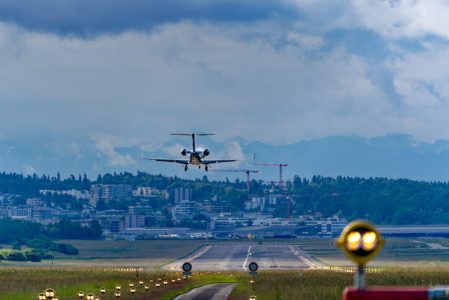What Is an SOIA?
A Simultaneous Offset Instrument Approach (SOIA) is a procedure that was created to conduct simultaneous approaches to runways that are spaced less than 3,000 feet, but more than 750 feet apart from each other. This procedure utilizes offset flight paths, ensuring that aircraft maintain safe separation during their final approach, minimizing the risk of collision.
SOIA Requirements
During SOIAs, each runway must use a different approach, one of which must be an ILS PRM approach. The other runway must use an offset Localizer Type Directional Aid (LDA) PRM approach with a glide slope or an RNAV PRM or GLS PRM approach with vertical guidance. There are also other requirements that must be met before SOIAs may be accomplished.
- Necessary Equipment:
- Advanced navigational systems like Instrument Landing System (ILS) or Localizer Performance with Vertical guidance (LPV).
- Transponders capable of Automatic Dependent Surveillance-Broadcast (ADS-B).
- Specialized Training:
- Completion of specific SOIA training modules to understand the intricacies of offset approaches.
- Regular proficiency checks to ensure skills are up to date.
- Procedural Knowledge:
- Detailed understanding of SOIA procedures, including approach paths, altitudes, and speed restrictions.
- Familiarity with the visual segment of the approach and how to execute offset alignments.
- Regulatory Compliance:
- Adherence to FAA regulations governing simultaneous approaches and runway separation standards.
- Knowledge of visibility and weather condition requirements for SOIA operations.
- Communication with ATC:
- Maintaining constant, clear communication with air traffic control during the entire approach process.
- Ability to respond promptly to ATC instructions and adjustments.
Differences Between SOIA and PRM Approaches
Understanding the differences between SOIA and PRM will help pilots and air traffic controllers determine the most appropriate approach method based on airport configurations and prevailing conditions, ensuring safe and efficient operations in complex airspace environments.
- Equipment:
- SOIA: Requires advanced navigational aids like the Instrument Landing System (ILS) or Localizer Performance with Vertical guidance (LPV). Aircraft must also be equipped with transponders capable of Automatic Dependent Surveillance-Broadcast (ADS-B).
- PRM: In addition to standard navigational equipment, PRM approaches require special radar technology and high-resolution displays to monitor aircraft with greater precision.
- Procedures:
- SOIA: Involves offset flight paths that allow aircraft to safely land on parallel runways that are spaced closer than the standard requirements. It includes a visual segment for alignment with the runway.
- PRM: Utilizes closely spaced parallel runways with high-precision monitoring, allowing simultaneous independent approaches. It doesn’t necessarily involve an offset but requires strict adherence to precise headings and altitudes.
- Runway Configurations:
- SOIA: Used for parallel runways that are spaced closer together than what is typically permissible for independent operations. The approach offsets slightly to allow visual separation in the final segment.
- PRM: Designed for closely spaced parallel runways, typically less than 4,300 feet apart, allowing for simultaneous independent approaches facilitated by precise monitoring.
- Operational Requirements:
- SOIA: Requires specific pilot training to handle the offset approach, including the transition from instrument to visual flight in the final segment.
- PRM: Demands enhanced coordination with air traffic control and the use of specialized equipment to ensure precise aircraft tracking and separation.
- Usage Conditions:
- SOIA: Primarily used in conditions where visual contact with the runway is possible, allowing pilots to execute the visual segment safely.
- PRM: Suitable for low visibility conditions due to the enhanced monitoring capabilities, allowing for continued operations even when visual separation is not feasible.
SOIA seems to be going the way of the NDB, but the FAA is keeping the approach procedures alive in case the need should arise for simultaneous landings to very close runways. It is still a good idea for pilots to know and understand the differences between parallel approaches in case anything changes.









